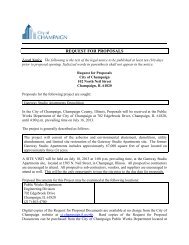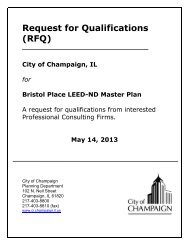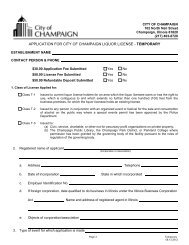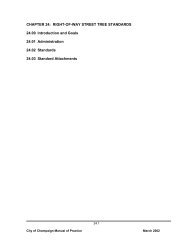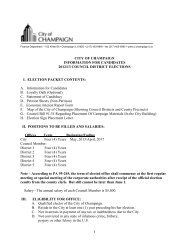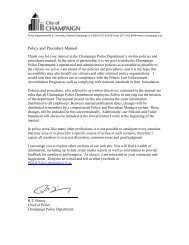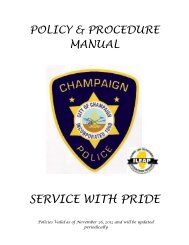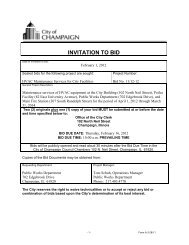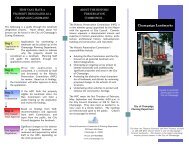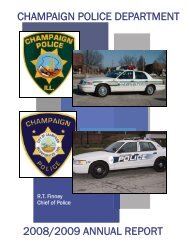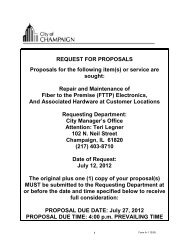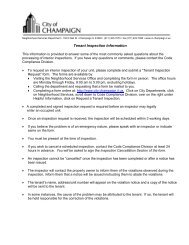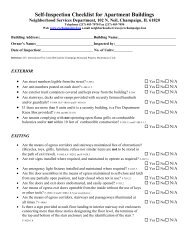Washington Street West watershed - City of Champaign
Washington Street West watershed - City of Champaign
Washington Street West watershed - City of Champaign
- No tags were found...
You also want an ePaper? Increase the reach of your titles
YUMPU automatically turns print PDFs into web optimized ePapers that Google loves.
6.0 SOLUTION DEVELOPMENTDraft Report<strong>West</strong> <strong>Washington</strong> <strong>Street</strong> Watershed Master Plan6.1 INTRODUCTIONAs part <strong>of</strong> the <strong>West</strong> <strong>Washington</strong> <strong>Street</strong> Watershed Master Plan, dozens <strong>of</strong> alternatives weredeveloped and presented to address the current flooding concerns. These options are discussed inthe sections that follow and include the implementation, benefits, shortcomings and operation <strong>of</strong>each alternative. Chapter 7 will follow with planning-level cost estimates and recommendations.6.2 PROPOSED SOLUTION DEVELOPMENTThe <strong>West</strong> <strong>Washington</strong> <strong>Street</strong> Watershed Master Plan Report was created to develop severalalternatives that improve hydraulic conditions in the trunk storm sewers with varying degrees <strong>of</strong>effectiveness, cost, and feasibility. The alternatives development for individual options wasdivided into four categories:• Stormwater Detention• Stormwater Sewer Improvements• Surface Conveyance Improvements• Local Improvement OptionsAll <strong>of</strong> the proposed alternatives fall into one <strong>of</strong> these four categories, with each <strong>of</strong> thesecategories serving a different purpose. The stormwater detention alternatives are designed todirect surface ponding into detention structures, as well as lowering the hydraulic grade linewithin the system. The zone <strong>of</strong> effectiveness for these improvements are typically limited to afew hundred feet in any direction, within the storm sewer system; however, directing surfaceponding into these structures can dramatically reduce surface flooding. Stormwater sewerimprovements are typically expensive, but provide additional sewer capacity that can be designedto limit surface flooding to only the largest <strong>of</strong> storm events. Smaller storm sewer improvementprojects are also possible to obtain some benefit without the large cost. The surface conveyanceimprovements are developed with the goal <strong>of</strong> moving surface flooding away from homes androads and directing it to the receiving waters or detention basins. These overland flow paths onlyconvey flows during the large storm events, but are beneficial during an emergency. The localimprovement options consist <strong>of</strong> low impact development or small scale alternatives that can beimplemented in either a single location or throughout the <strong>watershed</strong> for greater impacts.The primary objectives for alternative solution development were:• Develop alternatives that reduce surface flooding along the <strong>West</strong> <strong>Washington</strong> <strong>Street</strong>corridor through the implementation <strong>of</strong> stormwater detention structures that attainvarious levels <strong>of</strong> protection• Develop alternatives that reduce surface flow along the <strong>West</strong> <strong>Washington</strong> <strong>Street</strong> corridorthrough the implementation <strong>of</strong> storm sewers, achieving various levels <strong>of</strong> protection• Do not adversely impact other areas (i.e. the Copper Slough, Mattis Avenue low area)throughout the <strong>watershed</strong>, either by causing flooding in other areas or altering thetopography in a way that is unacceptable for local standards or current land useSeptember 20096-1Clark Dietz, Inc.



